 A Brief History of Toshiba Corporation / Dynabook - Part 2
A Brief History of Toshiba Corporation / Dynabook - Part 2
In Part 1 we covered Toshiba's early years, from 1985 through 1990. This saw laptops grow slowly in popularity due to their high relative price compared to desktops, poor battery life, and usualy pretty awful screens.
In Part 2 we'll cover 1991 to 1993 - a massive time of change for the market in many ways. Like others, Toshiba leveraged the pace of technological growth and shrinkage/consolidation of components. Most importantly, they started using NiMH batteries instead of NiCD ones (which offered lighter weight and slightly better battery life), and TFT displays were offered on their premium models, though monochrome LCD and colour passive matrix (STN and DSTN) were still options on many in their range.
| 1991 T2000SX (386SX-16, 1 MB RAM, 40 MB hard disk, 8.5" mono STN) T5200 (386SX-20, 2 MB RAM, 40 MB hard disk, mono gas plasma) T5200-100 (as T5200 but with 100 MB hard disk) T5200-200 (as T5200 but with 200 MB hard disk) T5200C (386SX-20, 4 MB RAM, 200 MB, active-matrix colour) 1992 T2200SX (386SX-20, 2 MB RAM, 60 MB, 9.5" mono STN display) T3300SL (386SL-20, 2 MB RAM, 80 MB, mono STN display) T4400SX (486SX-25, 4 MB RAM, 80 MB, 9" mono gas plasma) T4400SXC (as T4400SX but with 9" mono STN display) T4400C (486SX-25, 4 MB RAM, 213 MB, 9.5" colour TFT display) T6400SX (486SX-25, 4 MB RAM, 120 MB, mono gas plasma) |
T6400SXC (as T6400SX but with active matrix colour display) T6400 (486DX-33, 4 MB RAM, 200 MB, 10.4" mono gas plasma) T6400DXC (as T6400 but with 10.4" colour TFT display) 1993 T4500 (486SX-20, 4 MB RAM, 86 MB, 9.5" mono STN) T4500C (as T4500 but with colour STN display) Satellite T1850C (386SX-25, 4 MB RAM, 80 MB, 9.5" colour STN) Satellite T1900 (486SX-20, 4MB RAM, 80 MB, 9.5" mono STN) Satellite T1900C (as T1900 but with 9.5" colour DSTN display) Satellite T1900C-120 (as Satellite T1900C but with 120 MB ) Satellite T1900C-200 (as Satellite T1900C but with 200 MB ) |
1991
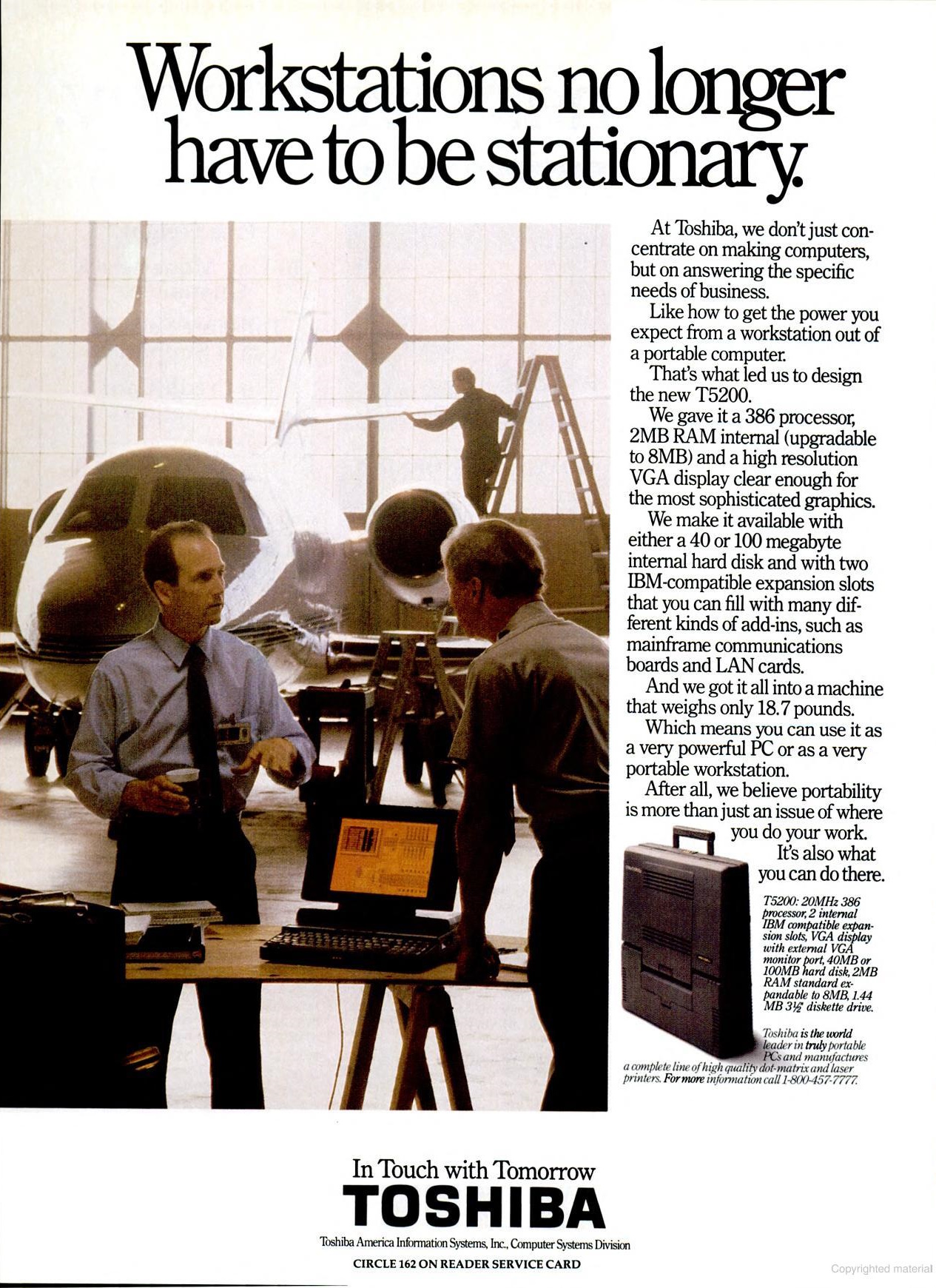 Laptop computer manufacturers were looking to provide a broader range of laptops at each price point, with 386SX-based notebooks at the $3,000 and higher price bracket, fast 80286 ones in the more cost-effective $2,000 bracket, and 8088/8086 machines still available at entry-level prices. With three different display types on offer, there was plenty of choice for everyone who wanted to take their computing on the road.
Laptop computer manufacturers were looking to provide a broader range of laptops at each price point, with 386SX-based notebooks at the $3,000 and higher price bracket, fast 80286 ones in the more cost-effective $2,000 bracket, and 8088/8086 machines still available at entry-level prices. With three different display types on offer, there was plenty of choice for everyone who wanted to take their computing on the road.
"Toshiba's 20-MHz, 386-based, AC-powered, $8,299 T5200/100 may dent your wallet, but it also blurs the distinctions between desktop and portable computer performance.
Along with its 3.5-inch internal floppy disk drive and fine VGA gas plasma display, the T5200/100 arrived for this review packed with a 104 MB hard disk. According to a Toshiba representative, the company's new philosophy
is to incorporate large hard disks into its entire portable line." PC Magazine, March 1990
In March 1991, Toshiba released the T5200 and T5200C models - both running a 386SX processor. At the time, Compaq's LTE 386s/20 was the fastest notebook on the market. Sporting a 386SX-20, the LTE 386s/20 was both lightweight and powerful, with an excellent built-in modem and large hard disk. If lightweight was your primary driver, the GRiDCase 1550SX
The T5200 weighed 18.7lbs, and ran a 386SX-20 with an 11.2" gas plasma mono VGA display. The 386SX came with a 32 KB L2 cache on the motherboard. Memory was standard at 2 MB, but could be upgraded to 8 MB. Several model variants exist, including the T5200 with a 40 MB Conner IDE hard disk, the T5200/100 which got a 100 MB Conner IDE hard disk, and the T5200/200 with its 200 MB Conner IDE hard disk.
"Toshiba's new color machine, the Toshiba T5200C, is a real breath of fresh air. The color looks more natural than other vendors' earlier attempts. Unfortunately, the T5200C is likely to be a showpiece rather than a workhorse. Since the system comes with a 19-pound handicap and a $10,000-plus price tag, you'll probably use the T5200C only if you absolutely, positively need portable VGA color. If that's the case, you should snap one up before they're all gone." PC Magazine, March 1991
The T5200C was the version that came with an active-matrix colour LCD, which added a further 0.2lbs to the weight, though visually you could not tell the difference between the T5200 and T5200C when powered off. Under the hood the T5200C came with a Phoenix BIOS that drove the chipset at a blistering 20 MHz, and a 32 KB RAM cache by Intel that was rated for 35ns. Interestingly, you could also opt to run the expansion (ISA) bus at either 8 or 10 MHz. Within the case you also got a full-length 16-bit expansion slot and a half-length 8-bit slot.
 All the T5200 range employed a Paradise PVGA-1 video chipset with 256 KB of video memory which provided up to 640 x 480 in 16 colours. Under a cover were two ISA slots - one 16-bit full-length, and a second 8-bit half-length - and a proprietary 16-bit Toshiba expansion slot.
All the T5200 range employed a Paradise PVGA-1 video chipset with 256 KB of video memory which provided up to 640 x 480 in 16 colours. Under a cover were two ISA slots - one 16-bit full-length, and a second 8-bit half-length - and a proprietary 16-bit Toshiba expansion slot.
The T5200 series looks like this:
- T5200 - 80386SX-20 CPU, 2 MB RAM, 32K RAM cache, 40 MB Conner hard disk, mono gas plasma display. US Model number PA8050U. Price: $8,999.
- T5200/100 - (as T5200 but with 100 MB Conner hard disk). US model number PA8052U.
- T5200/200 - (as T5200 but with 200 MB Conner hard disk). US model number PA8054U.
- T5200C - 80386SX-20 CPU, 4 MB of RAM, 32K RAM cache, 200 MB Conner hard disk, active-matrix colour display. Price: $10,498
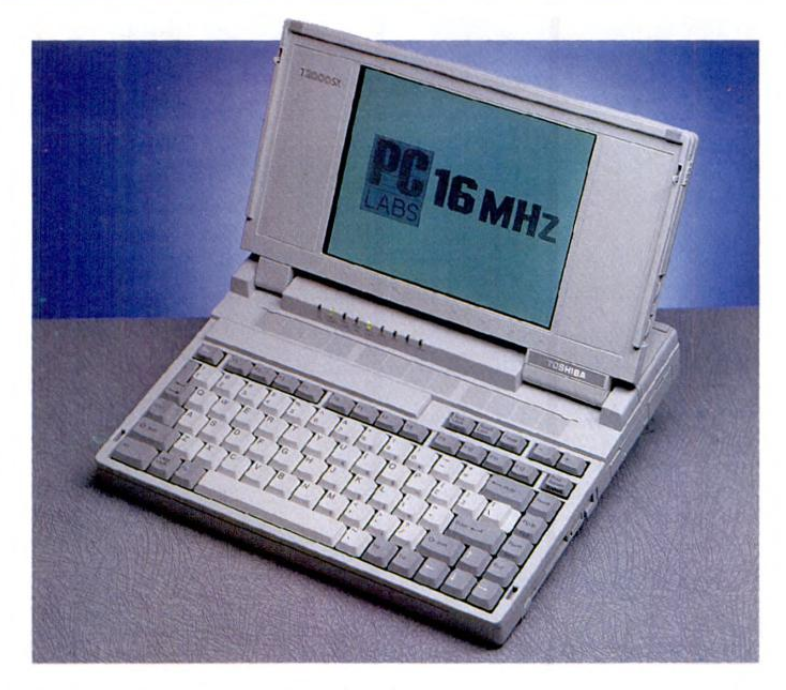 Around mid-1991, Toshiba launched their T2000SX which was their first laptop to make use of the latest in battery technology, nickel metal-hydride. At the time, Toshiba stated that nickel hydride batteries packed 22% more power per ounce than nickel cadmium, and they posed less of an environmental hazard. The battery provided was rated at 2200 mAh. It sported a 386SX-16 processor and 1 MB of RAM as standard, though it could be upgraded up to 9 MB with PCMCIA memory cards. Its graphics capabilities were VGA with 256 KB of dedicated video RAM though it could emulate CGA and EGA display standard, all displayable on the built-in monochrome 8.5" STN display that supported resolutions up to 640 x 480 in 16 gray scales.
Around mid-1991, Toshiba launched their T2000SX which was their first laptop to make use of the latest in battery technology, nickel metal-hydride. At the time, Toshiba stated that nickel hydride batteries packed 22% more power per ounce than nickel cadmium, and they posed less of an environmental hazard. The battery provided was rated at 2200 mAh. It sported a 386SX-16 processor and 1 MB of RAM as standard, though it could be upgraded up to 9 MB with PCMCIA memory cards. Its graphics capabilities were VGA with 256 KB of dedicated video RAM though it could emulate CGA and EGA display standard, all displayable on the built-in monochrome 8.5" STN display that supported resolutions up to 640 x 480 in 16 gray scales.
For storage, the laptop had a built-in 3.5" 1.44 MB floppy disk drive, and buyers had a choice of a Conner 20 MB (CP2024), 40 MB (CP2044) or 60 MB (CP2064) IDE hard disk.
The T2000SX came bundled with either Toshiba MS-DOS 4.01 or 5.0, though you could also purchase Toshiba MS OS/2 version 1.21.
1992
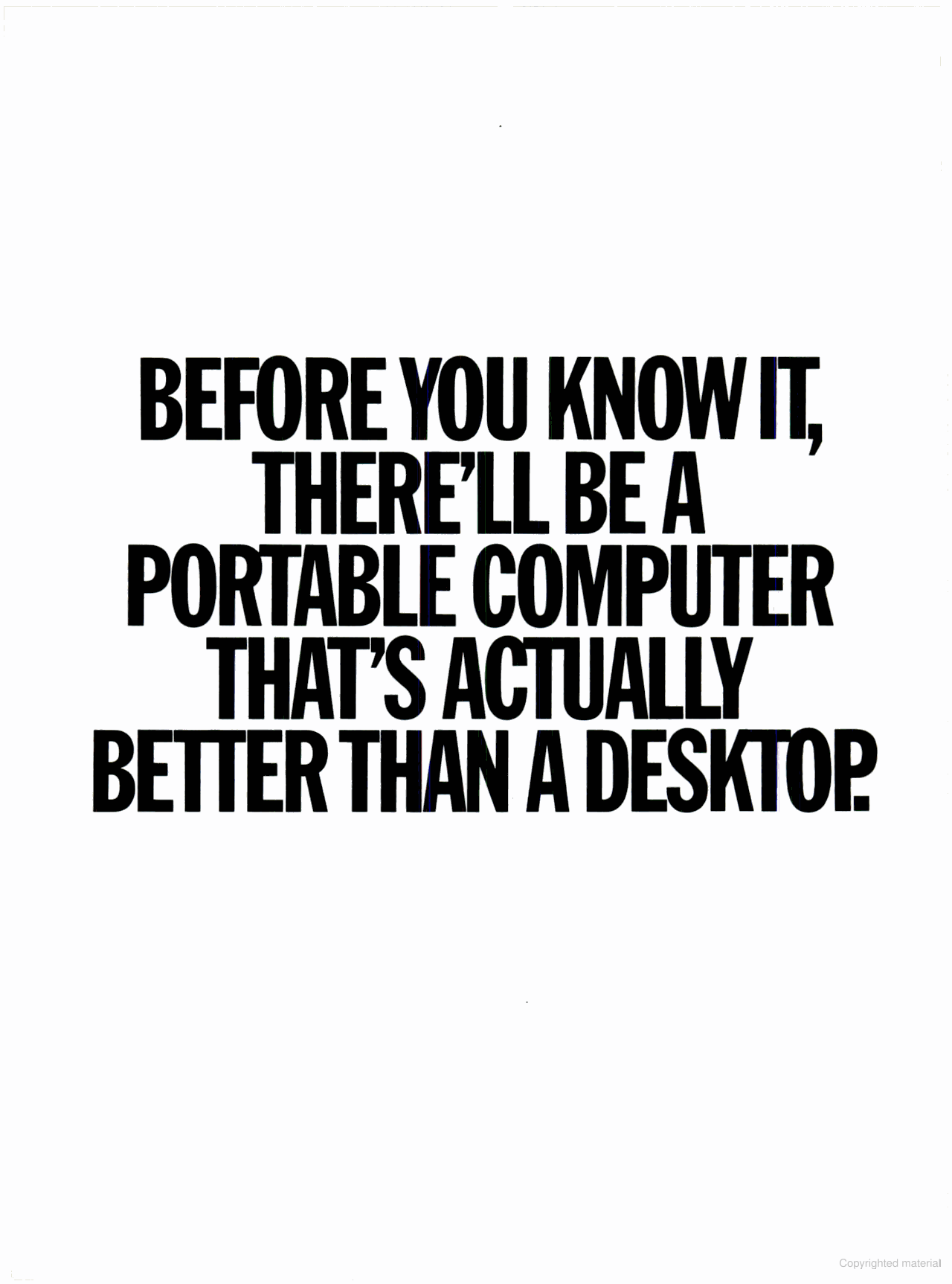
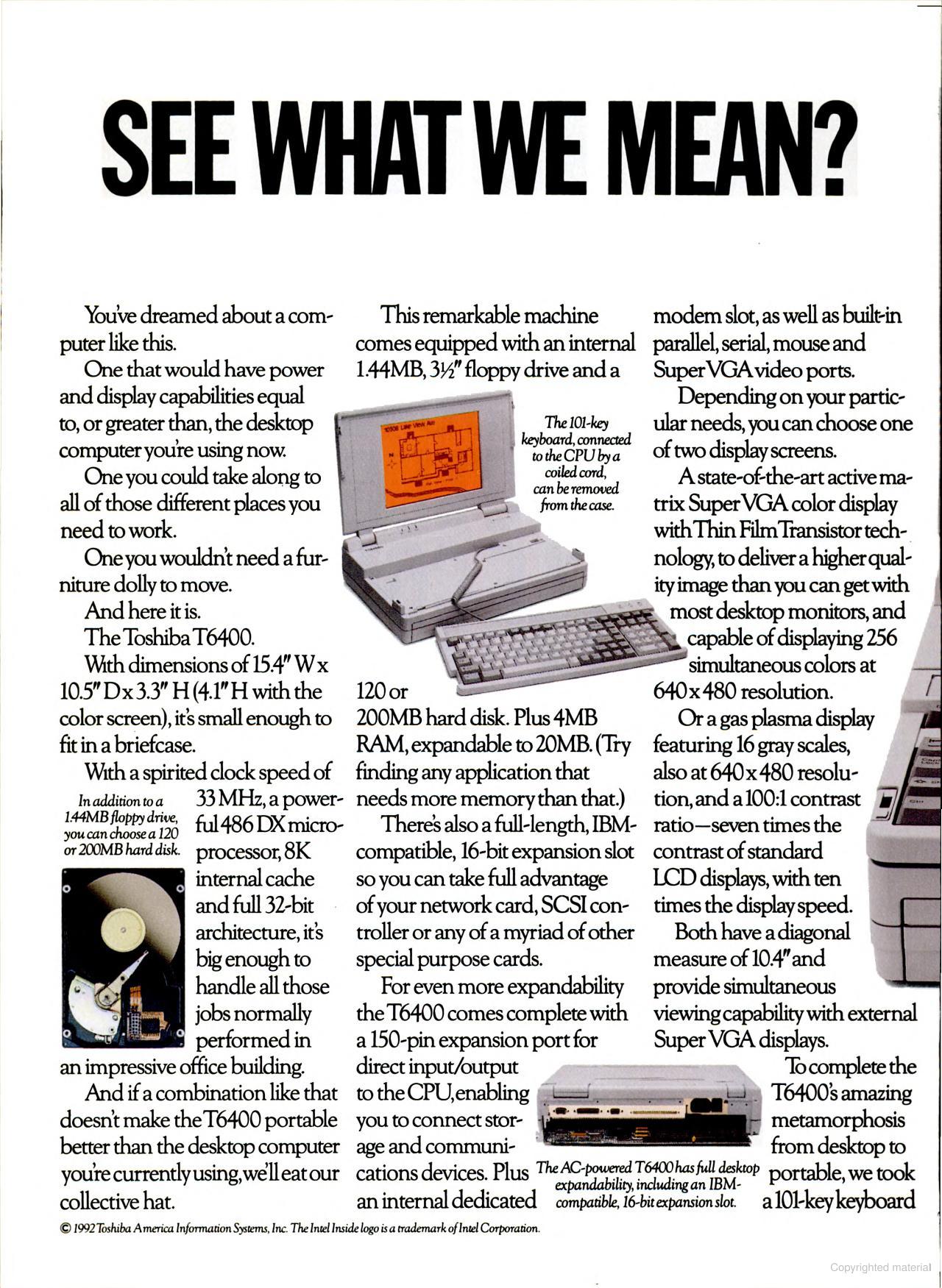
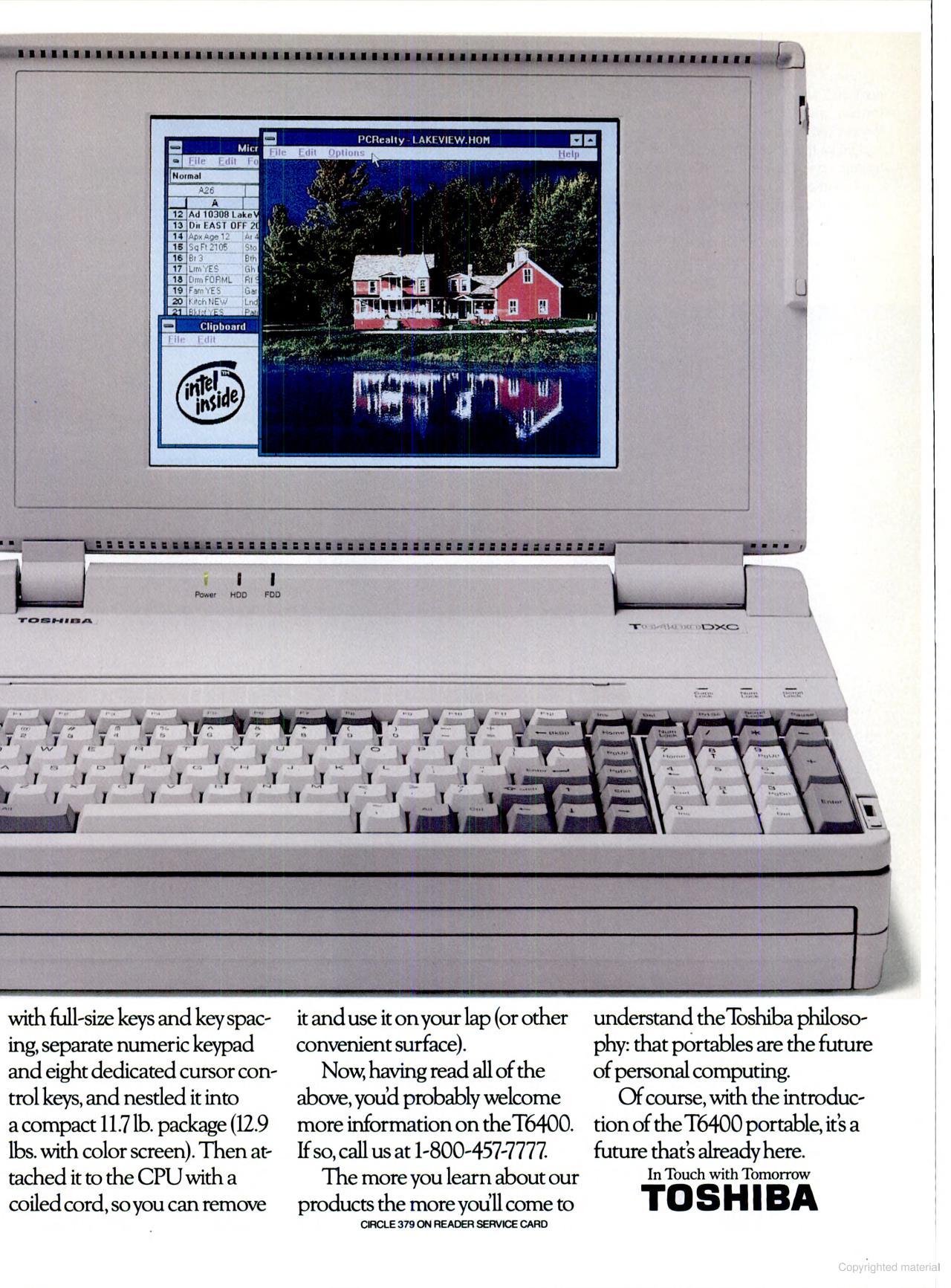 In 1992, Toshiba entered the 486 laptop market with their flagship T6400 series two 33 MHz 486DX-based and two 25 MHz 486SX ones. Weight reduction was again at the forefront of the design of these two new laptops, with monochrome gas plasma versions weighing 11.7lbs and active-matrix colour versions at 12.9lbs. This high-end series were all designed to be 'AC laptops only', meaning there was no battery - Toshiba was a firm believer in what they tended to call 'semi mobile' users who needed portability between locations, but not the need to use it while away from a power source. All models came with 4 MB of RAM. The 486SX machines got a 120 MB hard disk and DX-based machines got a 200 MB one.
In 1992, Toshiba entered the 486 laptop market with their flagship T6400 series two 33 MHz 486DX-based and two 25 MHz 486SX ones. Weight reduction was again at the forefront of the design of these two new laptops, with monochrome gas plasma versions weighing 11.7lbs and active-matrix colour versions at 12.9lbs. This high-end series were all designed to be 'AC laptops only', meaning there was no battery - Toshiba was a firm believer in what they tended to call 'semi mobile' users who needed portability between locations, but not the need to use it while away from a power source. All models came with 4 MB of RAM. The 486SX machines got a 120 MB hard disk and DX-based machines got a 200 MB one.
Here's the full range, along with their price at launch:
- T6400SX - 25 MHz 486SX, 4 MB RAM, 120 MB hard disk, monochrome gas plasma display. Price: $5,699
- T6400SXC - 25 MHz 486SX, 4 MB RAM, 120 MB hard disk, active matrix colour display. Price: $8,499
- T6400 - 33 MHz 486DX, 4 MB RAM, 200 MB hard disk, monochrome gas plasma display. Price: $6,999
- T6400DXC - 33 MHz 486DX, 4 MB RAM, 200 MB hard disk, active matrix colour display. Price: $9,749
"With its T6400 series, Toshiba America Information Systems is targeting the high-end portable-workstation market, which was until now dominated by Compaq and Dolch luggables. Unlike these pioneers, however, Toshiba has refined this well-designed active-matrix system to fit tightly into your briefcase. The Toshiba T6400DXC and Toshiba T6400SXC have a solid feel, good performance, and all the options you could want. Only their prices make you hesitate.
In spite of being smaller than the Compaq and Dolch luggables, the AC-only T6400s don't skimp. Each 12.6-pound system
is available with either a 486DX/33 ($9,948) or 486SX/25 ($8,648) processor and your choice of a 120 MB Conner CP-30104 or 200 MB Conner CP-30204 hard disk. Solidly-constructed, the 4.5-by 15.5-by 10.5-inch T6400 arrives with at least 4 MB of 65-nanosecond DRAM (expandable to 20 MB), a 1.44-inch floppy disk drive, a removable 101-key keyboard, and a gorgeous Toshiba trademark: a 10.4-inch active-matrix TFT (thin film transistor) color LCD screen." PC Magazine, August 1992
Another first for Toshiba, in 1992 they launched the T3300SL which used Intel's new low-power 386SL CPU running at 25 MHz. Power management was becoming a big deal by 1992 with mobile users expecting ever-longer battery life and easy standby/resume capability from their notebooks.
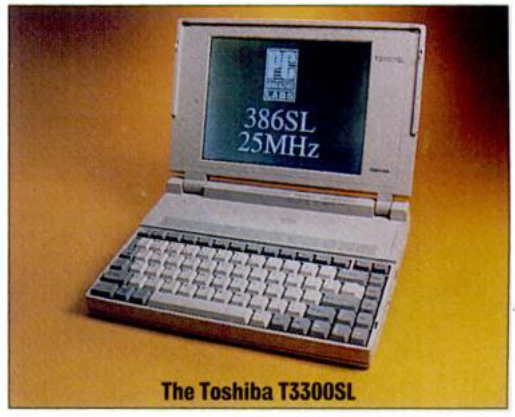 The T3300SL came with 2 MB of RAM as standard, expandable to 18 MB via a PCMCIA card slot (16 MB cards became available in May of 1992). Hard disk options included an 80 MB JVC drive or a 120 MB Toshiba one. The display was the same as that used on the T2200SX, offering monochrome VGA on its 9.5" STN screen which was sidelit and provided up to 32 greyscales. The notebook's overall size was typical of the time, measuring 11.7" x 8.3" x 1.8", and weighed in at a diminutive 4 lbs 11 oz without its battery or power adapter. All-in, its travel weight was a decent 7 lbs 1 oz.
The T3300SL came with 2 MB of RAM as standard, expandable to 18 MB via a PCMCIA card slot (16 MB cards became available in May of 1992). Hard disk options included an 80 MB JVC drive or a 120 MB Toshiba one. The display was the same as that used on the T2200SX, offering monochrome VGA on its 9.5" STN screen which was sidelit and provided up to 32 greyscales. The notebook's overall size was typical of the time, measuring 11.7" x 8.3" x 1.8", and weighed in at a diminutive 4 lbs 11 oz without its battery or power adapter. All-in, its travel weight was a decent 7 lbs 1 oz.
Like the T2000SX and T2200SX, it used a NiMH 2200mAh battery which claimed over 3 hours of life with continuous use. With power management over the screen, hard disk, floppy drive, and modem, the T3300SL could also put the CPU into 'Super Sleep' mode when you closed the lid.
The T3300SL came bundled with Toshiba-branded MS-DOS 5.0, and sold for $3,999.
"The $3,999 T3300SL (with 2MB of RAM and an 80MB JVC hard disk) represents the cutting edge of technology combined with usability. Function and form blend nicely in this 5.7-pound 386SL/25. Its cached processor and Western Digital video chip set match the performance of the [Dell] System 325N, its battery life of 3 hours 37 minutes ranks in the top ten percent of all notebooks, and its 120MB hard disk option would please many desktop PC owners.
One of the smallest AC power adapters around brings the travel weight of the T3300SL to just 7.1 pounds - a weight that would overburden few, and that remains beyond the reach of much of the competition. A bright, 9.5-inch backlit Toshiba display and a wonderful 82-key keyboard round off an ergonomically pleasing system." PC Magazine, August 1992
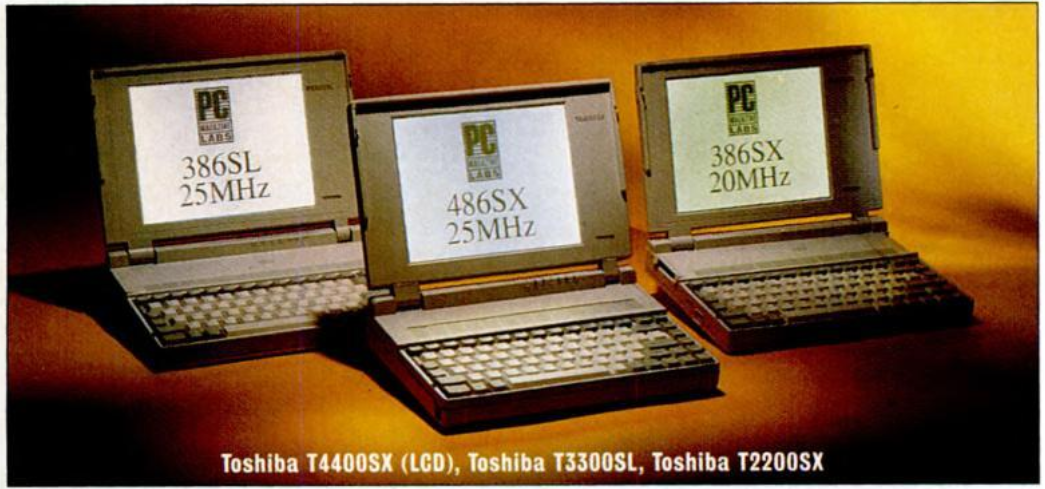 Sitting in the mid-range price bracket in 1992 was the A4-sized T4400SX. Like it bigger brother (the T6400SX series), the T4400SX had a 486SX-25 processor, 4 MB of RAM, and either an 80 MB Conner or 120 MB Conner or Toshiba hard disk.
Sitting in the mid-range price bracket in 1992 was the A4-sized T4400SX. Like it bigger brother (the T6400SX series), the T4400SX had a 486SX-25 processor, 4 MB of RAM, and either an 80 MB Conner or 120 MB Conner or Toshiba hard disk.
The monochrome display version, called T4400 offered a paper-white image on its LCD screen while the T4400C was the initial colour version, though it lacked the PCMCIA slot of the rest of the range.
The T4400SXC was the world's first TFT-screen 486 battery-powered notebook with a 9.5" display, able to show up to 640 x 480 resolution. Its embedded graphics card was a Paradise PVGA-1F (Western Digital WD90C30) with 256 KB of dedicated video RAM.
The T4400 range took a step back with its use of a NiCD battery pack, though it was rated for 2400 mAh to try and make up for its older technology over the now standard 2200 mAh NiMH ones used in other Toshiba machines.
"If you need MIPS, your best choice is the 25-MHz Toshiba T4400SX, the only 486-based notebook computer among the 14 we reviewed. It is the fastest notebook by a healthy margin and has the longest battery life. Its travel weight, a bit less than 9 pounds with its battery and AC adapter, would have been sensational a year ago. Here, it represents a 2- to 3-pound disadvantage, and at more than $6,000 with 4MB of RAM, an 80MB hard disk, and DOS, it is one of the more expensive systems.
The 486SX-based Toshiba T4400SX outperformed all the 386-family notebooks on the processor and memory benchmark tests. The Compaq LTE Lite/25 and ZDS MastersPort 386Le, with their cached 386SL/25 CPUs, turned in processor scores about 45 percent better than the Toshiba T2200SX, a 386SX/20. The AST Premium Exec 386SX/25's CPU also
outperformed that of the Toshiba T2200SX.
When your budget calls for something less than the Toshiba T4400SX's size and $6,000-plus price, however, you still have two excellent choices - the Compaq LTE Lite/25 and the Toshiba T2200SX. The 25-MHz SL-based Compaq PC has superior CPU and video performance, a host of security features, simultaneous internal and external display, Super VGA video output, and (finally!) an inverted T-cursor-key layout.
A $4,298 price for a system with an 84MB hard disk ($3,794 for the 60MB model) makes Compaq much more price-competitive. The company also offers a 20-MHz version, the Compaq LTE Lite/20, but what you give up in performance and base-level features outweighs the $500 to $600 price difference, in our opinion.
The 386SX/20-based Toshiba T2200SX ($4,778 with a 60MB hard disk) is one of the most convenient, well-rounded systems of the lot. It has first-class video performance, weighs just 6.5 pounds with its AC power adapter, and runs more than 3 hours on batteries. Lighter systems had shorter battery lives while longer-lasting notebooks were heavier.
If a long battery life is your biggest concern, look at the Toshiba T4400SX, the AT&T Safari, and the AST Premium Exec. It doesn't matter how they got there (big batteries, a good design, or both); all three lasted for more than 4 hours on PC Magazine's Battery Rundown test."
PC Magazine, April 1992
Also in 1992 Toshiba refreshed last year's low-end T2000SX with the T2200SX. This got a slightly faster 386SX-20 processor, 2 MB of memory which was expandable to 10 MB via its proprietary memory card slot, and a 9.5" monochrome STN display. Hard disks started at 40 MB, though 60 MB and 80 MB units were also available as standard model variants. The largest of these was Toshiba's first move away from their relationship with Conner, instead using a JVC drive, model JDE2085M.
1993
Still more to come...